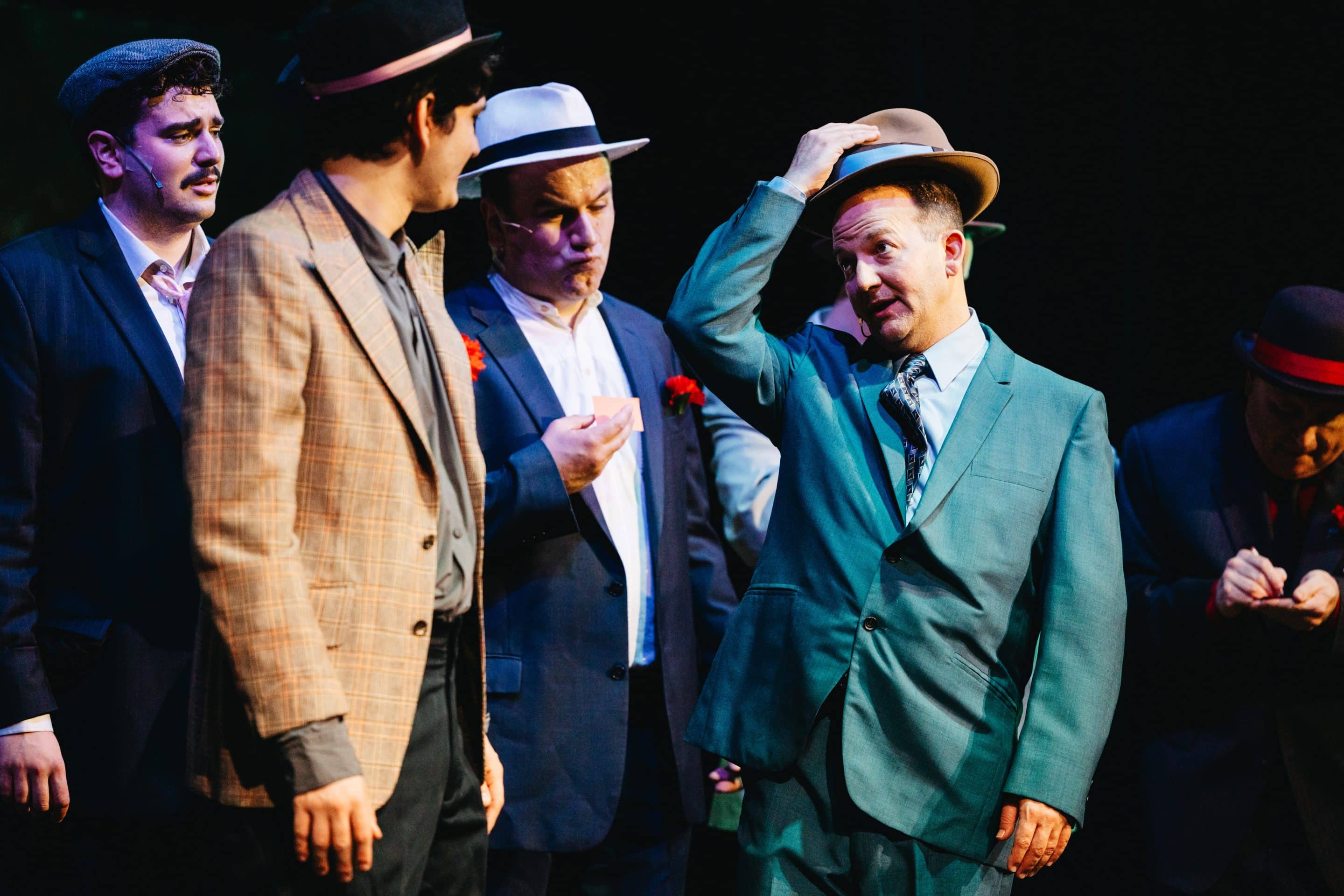Jason Rose-Langston’s Sky Masterson talks to the other gamblers in Easthampton Theater Company’s production of “Guys and Dolls.”
Photo credit: Jared Herman, Easthampton Theater Company
EASTHAMPTON — Gambling is serious business, but audiences will get plenty of laughs watching Easthampton Theater Company’s production of “Guys and Dolls,” a 1950 musical by Jo Swerling and Abe Burrows, with music and lyrics by Frank Loesser. The musical is based on the 1933 short story, “The Idyll of Miss Sarah Brown,” by Damon Runyon.
I first saw “Guys and Dolls” as a 17-year-old in the late 1990s and was captivated by the wit and charm of professional gambler Sky Masterson, the pious but naive Sarah Brown and the sentimental love of hopeful Miss Adelaide and hapless Nathan Detroit. Seeing it again, as a 44-year-old in 2025, I wondered if I would find the musical as “nicely-nicely” as I did the first time around.
The lead actors are excellent, both in terms of their voice and their acting. Jason Rose-Langston’s Sky Masterson is just as smooth and debonair when courting Sarah Brown as he is clever and calculating when making a bet. Brown’s earnestness and religious devotion are believable as played by Maddy Oldenburg, who also acts convincingly when the character is intoxicated — more on that later.
Evan Garber nails the nervous nature of Nathan Detroit, a character who is always at risk of being caught in a lie by police Lieutenant Brannigan or his long-suffering fiancé, Adelaide. Here, Cassie Wood-Triplett carries all the weariness one would expect in someone who has been engaged for 14 years but balances it with the love and understanding she would need to put up with having the big day put off for so long.
Manny Morales stole every scene he was in as Nicely-Nicely Johnson, Detroit’s loveable sidekick who adds humor to the exposition that he and Zachary Siano as Benny’s Southstreet provide. Both actors give their all, with Morales proving his vocal chops in a raucous church revival number in the second act.
With a live orchestra, the music fills the space wonderfully. Aside from a couple of moments when the mics cut out, the sound was engineered well. One issue that was quite noticeable was a mismatch in voices. Oldenburg is a vocal powerhouse, which unfortunately meant that her soprano overwhelmed the voices of her costars, particularly in duets with Rose-Langston and Wood-Triplett, each of whom had chances to let their voices shine in other scenes. On a separate note, Rose-Langston brings down the house with his rendition of “Luck Be a Lady,” the musical’s most famous song.
There are two show-within-a-show scenes set at The Hot Box, the club where Adelaide dances, including one that gave rise to the well-known song “A Bushel and a Peck,” featuring Adelaide and the Hot Box girls performing basic steps, choreographed by Director Eva Husson-Stockhammer. Both of these scenes could have used more refinement and energy.
While not the fault of the cast or crew of this production, two scenes that did not occur to me as problematic in the 1990s have aged like milk. The first is a scene set in Havana, Cuba, where Masterson takes Brown for dinner. When Brown orders a milkshake, Masterson tells the waitstaff to bring alcoholic dulce de leche. After several of these, Brown is intoxicated. To the story’s credit, Masterson does not take advantage of her state, but, to my 2025 sensibilities, a scene involving a person being given alcohol unknowingly should not be played for laughs. The other scene comes in the second act, when Brown and Adelaide sing about changing their men, an idea that is generally considered manipulative and outdated. That said, the scenes can be viewed through the lens of the era they were penned in, and do not otherwise detract from the enjoyment of the show.
This production, produced by Michael O. Budnick, is staged at the Williston Theater. The relatively small venue required the set pieces to be compact and easy to change. Aside from some seating and a bookcase, the set consisted of five multi-sided, rotatable sections of wall that were spun to the correct background for a given scene. The set crew largely consists of what Budnick described as “aspiring theater kids” from area middle schools. This is part of Easthampton Theater Company’s mission to introduce young people to the theater.
“Guys and Dolls” continues its run at the Williston Theater, 18 Payson Ave., on Friday, June 27 and Saturday, June 28 at 7:30 p.m., with a finale on Sunday, June 29 at 2 p.m.



